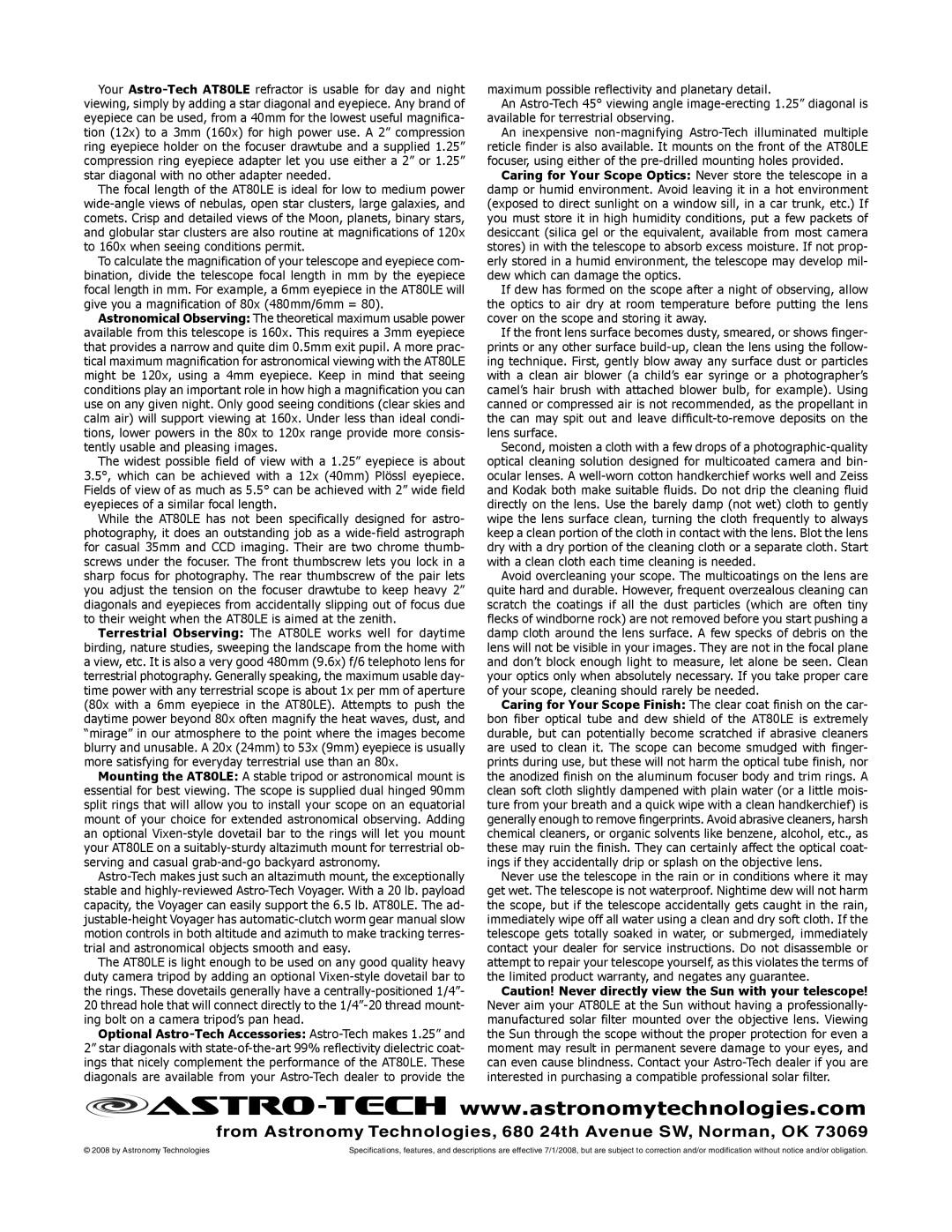Your
The focal length of the AT80LE is ideal for low to medium power
To calculate the magnification of your telescope and eyepiece com- bination, divide the telescope focal length in mm by the eyepiece focal length in mm. For example, a 6mm eyepiece in the AT80LE will give you a magnification of 80x (480mm/6mm = 80).
Astronomical Observing: The theoretical maximum usable power available from this telescope is 160x. This requires a 3mm eyepiece that provides a narrow and quite dim 0.5mm exit pupil. A more prac- tical maximum magnification for astronomical viewing with the AT80LE might be 120x, using a 4mm eyepiece. Keep in mind that seeing conditions play an important role in how high a magnification you can use on any given night. Only good seeing conditions (clear skies and calm air) will support viewing at 160x. Under less than ideal condi- tions, lower powers in the 80x to 120x range provide more consis- tently usable and pleasing images.
The widest possible field of view with a 1.25” eyepiece is about 3.5°, which can be achieved with a 12x (40mm) Plössl eyepiece. Fields of view of as much as 5.5° can be achieved with 2” wide field eyepieces of a similar focal length.
While the AT80LE has not been specifically designed for astro- photography, it does an outstanding job as a
Terrestrial Observing: The AT80LE works well for daytime birding, nature studies, sweeping the landscape from the home with a view, etc. It is also a very good 480mm (9.6x) f/6 telephoto lens for terrestrial photography. Generally speaking, the maximum usable day- time power with any terrestrial scope is about 1x per mm of aperture (80x with a 6mm eyepiece in the AT80LE). Attempts to push the daytime power beyond 80x often magnify the heat waves, dust, and “mirage” in our atmosphere to the point where the images become blurry and unusable. A 20x (24mm) to 53x (9mm) eyepiece is usually more satisfying for everyday terrestrial use than an 80x.
Mounting the AT80LE: A stable tripod or astronomical mount is essential for best viewing. The scope is supplied dual hinged 90mm split rings that will allow you to install your scope on an equatorial mount of your choice for extended astronomical observing. Adding an optional
The AT80LE is light enough to be used on any good quality heavy duty camera tripod by adding an optional
Optional
maximum possible reflectivity and planetary detail.
An
An inexpensive
Caring for Your Scope Optics: Never store the telescope in a damp or humid environment. Avoid leaving it in a hot environment (exposed to direct sunlight on a window sill, in a car trunk, etc.) If you must store it in high humidity conditions, put a few packets of desiccant (silica gel or the equivalent, available from most camera stores) in with the telescope to absorb excess moisture. If not prop- erly stored in a humid environment, the telescope may develop mil- dew which can damage the optics.
If dew has formed on the scope after a night of observing, allow the optics to air dry at room temperature before putting the lens cover on the scope and storing it away.
If the front lens surface becomes dusty, smeared, or shows finger- prints or any other surface
Second, moisten a cloth with a few drops of a
Avoid overcleaning your scope. The multicoatings on the lens are quite hard and durable. However, frequent overzealous cleaning can scratch the coatings if all the dust particles (which are often tiny flecks of windborne rock) are not removed before you start pushing a damp cloth around the lens surface. A few specks of debris on the lens will not be visible in your images. They are not in the focal plane and don’t block enough light to measure, let alone be seen. Clean your optics only when absolutely necessary. If you take proper care of your scope, cleaning should rarely be needed.
Caring for Your Scope Finish: The clear coat finish on the car- bon fiber optical tube and dew shield of the AT80LE is extremely durable, but can potentially become scratched if abrasive cleaners are used to clean it. The scope can become smudged with finger- prints during use, but these will not harm the optical tube finish, nor the anodized finish on the aluminum focuser body and trim rings. A clean soft cloth slightly dampened with plain water (or a little mois- ture from your breath and a quick wipe with a clean handkerchief) is generally enough to remove fingerprints. Avoid abrasive cleaners, harsh chemical cleaners, or organic solvents like benzene, alcohol, etc., as these may ruin the finish. They can certainly affect the optical coat- ings if they accidentally drip or splash on the objective lens.
Never use the telescope in the rain or in conditions where it may get wet. The telescope is not waterproof. Nightime dew will not harm the scope, but if the telescope accidentally gets caught in the rain, immediately wipe off all water using a clean and dry soft cloth. If the telescope gets totally soaked in water, or submerged, immediately contact your dealer for service instructions. Do not disassemble or attempt to repair your telescope yourself, as this violates the terms of the limited product warranty, and negates any guarantee.
Caution! Never directly view the Sun with your telescope! Never aim your AT80LE at the Sun without having a professionally- manufactured solar filter mounted over the objective lens. Viewing the Sun through the scope without the proper protection for even a moment may result in permanent severe damage to your eyes, and can even cause blindness. Contact your
![]() astro-tech
astro-tech
from Astronomy Technologies, 680 24th Avenue SW, Norman, OK 73069
© 2008 by Astronomy Technologies | Specifications, features, and descriptions are effective 7/1/2008, but are subject to correction and/or modification without notice and/or obligation. |
